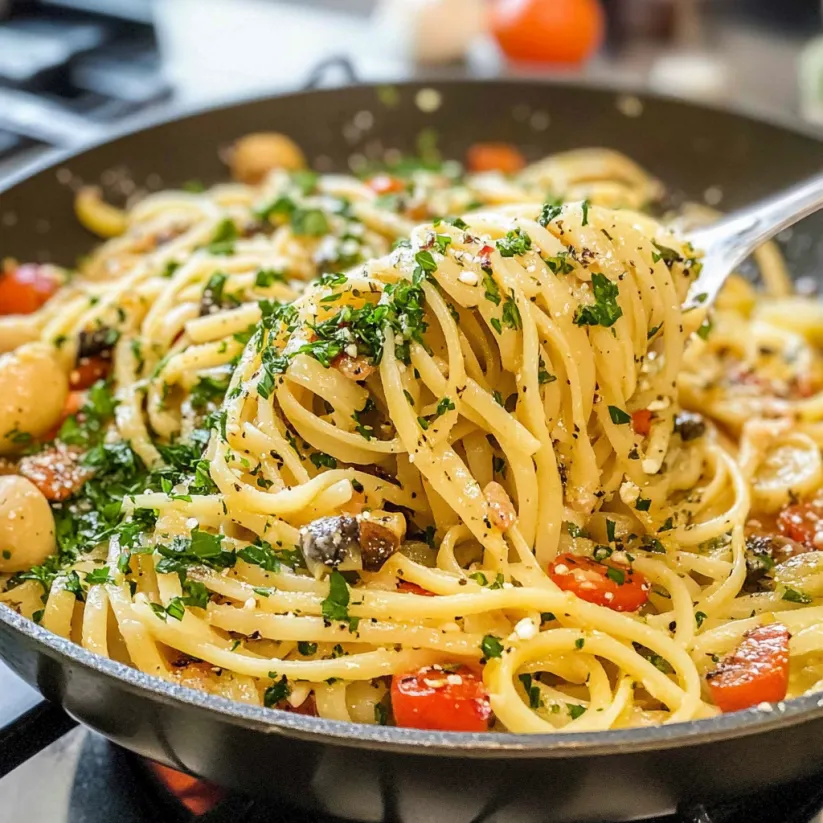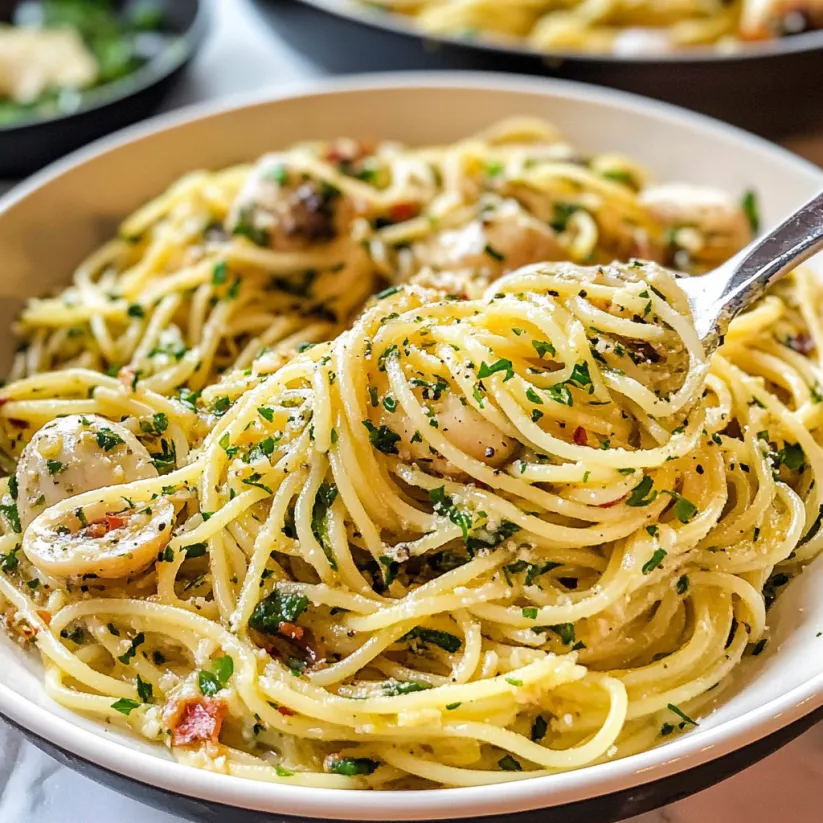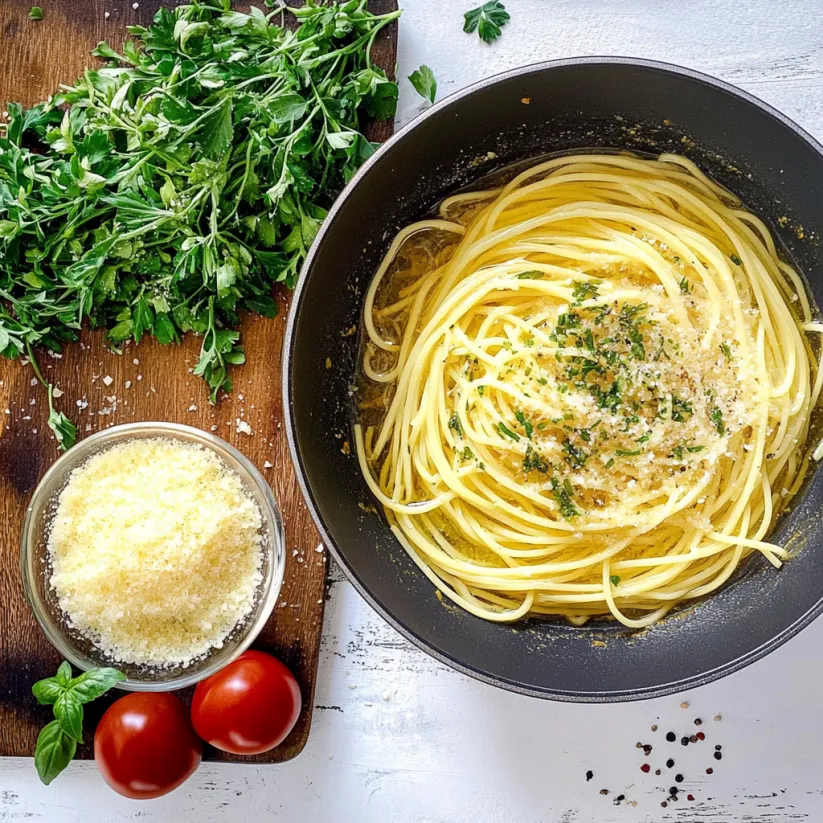 Save Pin
Save Pin
This classic Italian pasta dish transforms humble pantry staples into a delicious meal in just 15 minutes. Perfect for busy weeknights, Aglio e Olio delivers the authentic flavors of Italy with minimal effort and maximum satisfaction, proving that sometimes the simplest recipes are truly the most delicious.
I first discovered this recipe during my college years when I needed quick, budget-friendly meals. Years later, it remains my go-to comfort food when I need something satisfying without much fuss. The way the kitchen fills with the aroma of garlic and olive oil still brings me back to those early cooking adventures.
Ingredients
- 1 pound linguini. The long strands perfectly capture the simple sauce. Quality pasta makes a difference here.
- ¾ cup olive oil. The foundation of the dish so use the best extra virgin olive oil you can afford for maximum flavor.
- 1 head garlic peeled and sliced. Creates the signature flavor profile. Fresh garlic is essential here.
- 2 teaspoon red pepper flakes. Provides a pleasant warming heat that balances the richness.
- ½ teaspoon salt or to taste. Enhances all the flavors in the dish.
- ½ teaspoon pepper or to taste. Adds a subtle complexity to the background.
- ½ cup fresh chopped parsley. Brings brightness and color to the finished dish.
Optional toppings
- ½ cup freshly grated Parmesan cheese. Adds a savory umami element.
- Freshly squeezed lemon juice. The acidity cuts through the richness of the oil.
Step-by-Step Instructions
- Boil the Pasta
- Bring a large pot of water to a boil and heavily salt it. The water should taste like seawater. Add the linguini and cook until al dente, about 7-8 minutes or according to package directions. The pasta should have a slight bite to it as it will continue cooking slightly in the sauce.
- Prepare the Garlic Oil
- While pasta is cooking, heat the olive oil in a large deep skillet over medium heat. Watch carefully as the oil begins to shimmer. This is the foundation of your sauce so give it proper attention.
- Infuse the Flavors
- Once the oil is simmering add the garlic slices and the red pepper flakes and stir continuously. Cook for 2-3 minutes until the garlic turns slightly golden brown but not dark. This is the most crucial step. Dark garlic turns bitter. Season with salt and pepper to taste.
- Combine and Finish
- Lower the heat to a medium-low and add the drained cooked pasta and the fresh parsley. Toss thoroughly to coat every strand with the fragrant oil. If the pasta seems dry add some of the reserved pasta water, about half a cup. The starchy water helps create a silky texture.
- Garnish and Serve
- Finish with a squeeze of fresh lemon juice and a generous sprinkle of freshly grated parmesan cheese. Serve immediately while hot, twirling the pasta into neat nests on warmed plates.
 Save Pin
Save Pin
My absolute favorite part of this recipe is the moment when the garlic begins to release its aroma into the olive oil. That fragrance filling my kitchen never fails to make me hungry. My children now recognize this smell as dinner time and come running to the kitchen asking if we're having "the special pasta" tonight.
The Secret to Perfect Aglio e Olio
The most crucial element of this dish is managing the garlic cooking process. You want to achieve that perfect golden color without burning. When garlic burns, it becomes bitter and can ruin the entire dish. I recommend slicing the garlic rather than mincing it, as larger pieces are less likely to burn. Keep the heat medium-low and stir frequently, watching for that moment when the garlic just begins to take on a light golden hue. Remove from heat immediately if you see it darkening too quickly.
Make It Your Own
While traditional Aglio e Olio is beautifully simple, you can adapt it to your taste or what you have available. Add a handful of halved cherry tomatoes in the last minute of cooking for a burst of freshness. For protein, consider adding sautéed shrimp or chicken. For a vegetable boost, wilt some baby spinach or arugula into the hot pasta. Toasted breadcrumbs make a fantastic crunchy topping if you enjoy textural contrast. These additions maintain the spirit of the dish while allowing for personal expression.
A Bit of History
Aglio e Olio hails from Naples, Italy, and is one of the most ancient pasta recipes in Italian cuisine. It was originally a dish of necessity, created by fishermen who needed something quick and satisfying after returning from their work at sea. The simplicity reflects the humble origins of many classic Italian dishes, where quality ingredients prepared simply often create the most memorable meals. This dish demonstrates the Italian philosophy of "cucina povera" or "poor cooking" that transforms humble ingredients into extraordinary meals.
 Save Pin
Save Pin
Commonly Asked Questions
- → What type of pasta works best for Aglio e Olio?
While linguini and spaghetti are traditional choices for Aglio e Olio, any long pasta works beautifully. The key is cooking it until al dente (still slightly firm) to give the dish proper texture. Long strands allow the garlic-infused oil to cling evenly throughout.
- → How do I prevent the garlic from burning?
To prevent garlic from burning, slice it thinly rather than mincing it, and cook over medium to medium-low heat. Watch carefully as it turns golden – this is the perfect moment to capture maximum flavor without bitterness. Remove from heat immediately if the garlic starts to darken too quickly.
- → Can I make Aglio e Olio without red pepper flakes?
Yes, you can omit the red pepper flakes if you prefer a milder dish. The garlic and olive oil alone create a delicious flavor base. Alternatively, add just a pinch for subtle warmth without significant heat, or substitute with freshly ground black pepper.
- → Why is pasta water important in this dish?
Pasta water is crucial as its starchiness helps create a silky sauce that clings to the pasta. Reserve about half a cup before draining, then add as needed to achieve the perfect consistency. The dissolved starches act as a natural thickener while the salinity enhances overall flavor.
- → What's the best olive oil to use for Aglio e Olio?
Since olive oil is a starring ingredient, use the highest quality extra virgin olive oil you can afford. Look for oils with a fruity, peppery profile that will complement the garlic. A good EVOO makes a noticeable difference in the final flavor of this simple dish.
- → Can I prepare Aglio e Olio in advance?
Aglio e Olio is best enjoyed immediately after preparation when the pasta texture is perfect and the flavors are freshest. If necessary, you can prepare the garlic-infused oil ahead of time and reheat gently before tossing with freshly cooked pasta and parsley.
